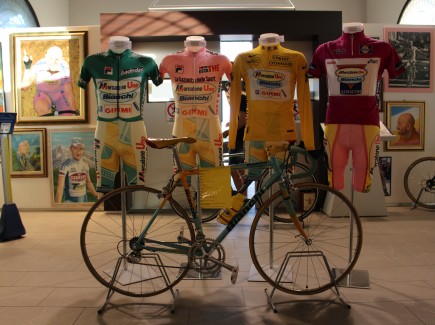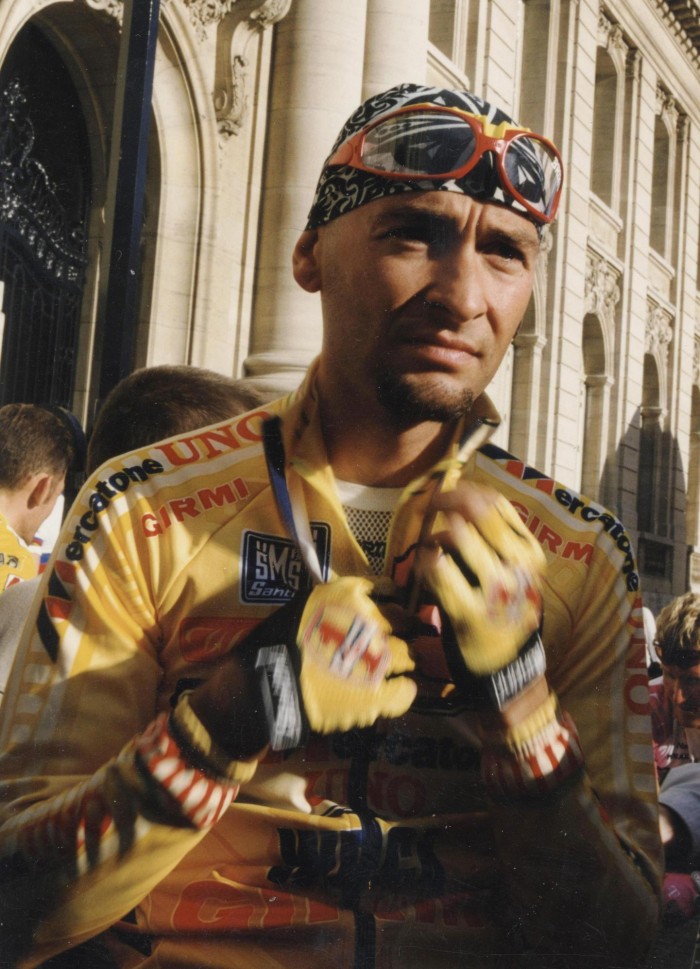In Emilia Romagna, on the Adriatic coast of Italy, Iain Treloar goes riding with a ghost.
The facts are these. In the mid to late ‘90s, the charismatic Italian climber Marco Pantani ascended to a godlike status in Italy. He’s a member of a disgraced generation of riders and almost certainly doped throughout his career, but his fans adore him with a unique fervor. Pantani’s story does not have a happy ending; after winning a rare Giro/Tour double in 1998—a feat not repeated since—his expulsion from the 1999 Giro d’Italia sent shockwaves through Italy. Pantani’s life spiralled out of control in a haze of white-lines and depression, until his death, alone on Valentine’s Day 2004, in a Rimini hotel room from a cocaine overdose.
The story of cycling in Emilia Romagna is impossible to tell without his mention. Resident of Cesenatico from birth to his death, Pantani’s boyish frame continues to cast a long shadow. Graffiti and murals in his memory can be seen all over the region—there are little reminders of Pantani everywhere. A scrawled slogan – “A true pirate never dies” – adorns a freeway underpass; a caricature of Pantani’s face stands out, ghostly white on the wall of an electrical sub-station. In death, Pantani has passed into immortality. In this staunchly Catholic country, his deification is almost blasphemous, or something very close to it.
Throughout my time in Italy, I ride the roads Pantani trained on. I climb his favourite training ground, Monte Vecchio, each hairpin with the famously stylised inscription of his surname stencilled across the road. I ride in a Gran Fondo in his memory, lining up on the starting grid behind his family members; the course takes a detour past his plush villa in the countryside. At event registration, I get given a t-shirt that reads “Pantani Forever”, and when I cross the finish line a medal with his face is hung around my neck.
So I think about him a lot, his life and his death, and try to pin down what is so magnetic about this flawed, tragic figure—even now, a decade after his death.
He was, I’m told, a simple boy who got caught up with the wrong crowd. He’s Cesenatico’s favourite son. He’s a myth, a spark that burnt too bright, human, ghost, cipher. Those who knew him refer to him as ‘the greatest’, and are reluctant to condemn him. And those who’ve lost faith in the athletic performances of that era—myself included—find it difficult to speak out against him, because he suffered greatly in life and surely deserves some peace in death. Perhaps it’s the fact that he displayed relatable human frailty. Pantani was never robotic; he was panache and pain astride a Bianchi.
At Cesenatico’s train station, there’s a small but touching museum dedicated to his life, open 365 days a year. Even Christmas, I ask? Yes, even Christmas. On the wall above the entrance, an automaton of Pantani pedals onward forever; the Italian public aren’t willing to let him hang up his cycling shoes. The Sisyphean task of Pantani, to appease the demands of his public, continues even beyond the grave.
There’s a lot of emotion in the story of Pantani to chew on. The melancholy of his tale is a toffee that gums up the mouth and fatigues the jaw, but it’s delicious in its pain.

This is an excerpt from the cover story in our October/November issue, available from the 1st October.
Main image supplied; museum photo by Iain Treloar.
Ride On content is editorially independent, but is supported financially by members of Bicycle Network. If you enjoy our articles and want to support the future publication of high-quality content, please consider helping out by becoming a member.

